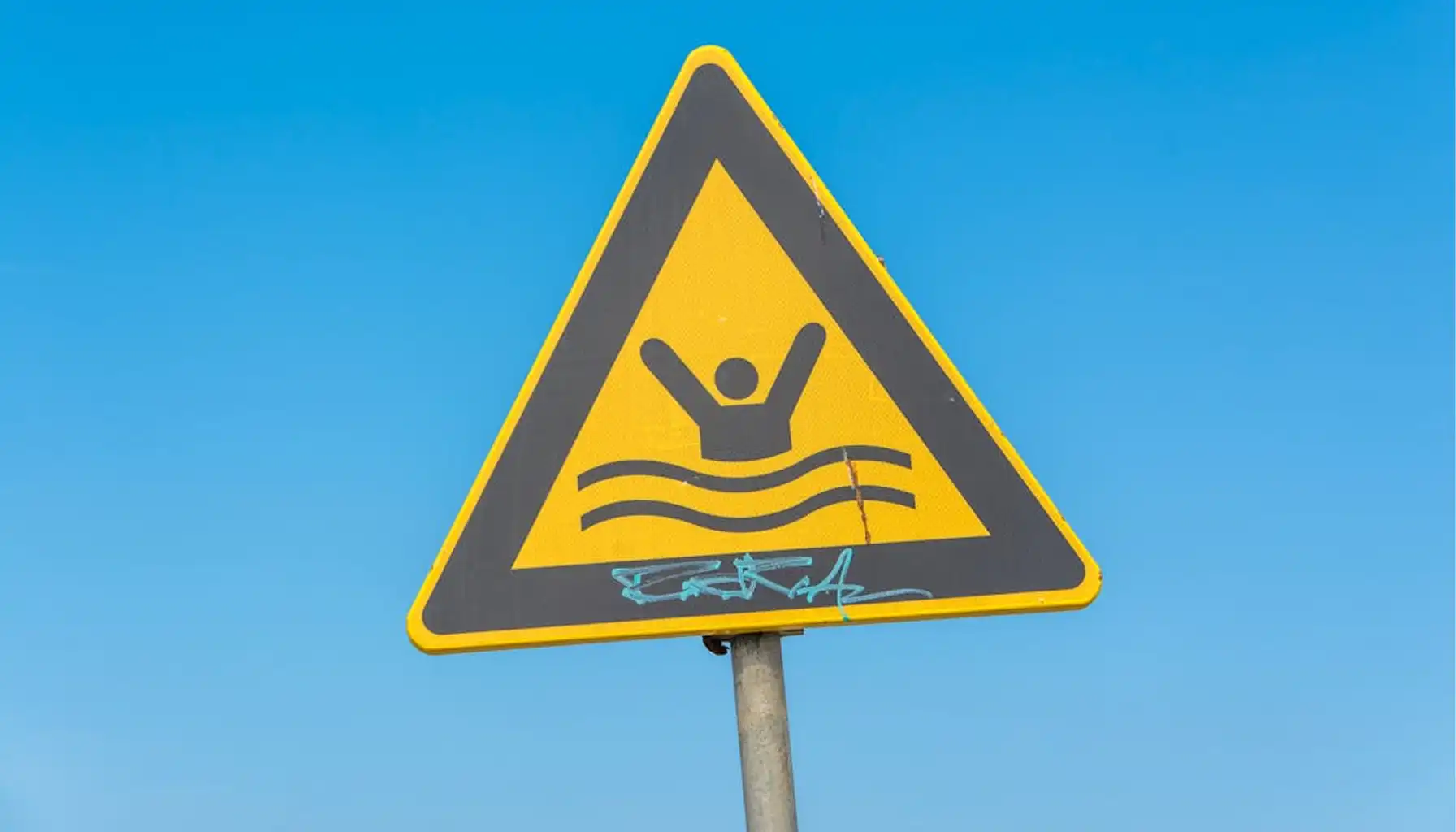Contents:
Aquaphobia, or the fear of water phobia, is a persistent fear that can make even shallow water, bathtubs, or splashing sounds feel threatening. Yes, many people can be hesitant around water they can’t swim in, but aquaphobia is something different: it can trigger physical tension, rapid heartbeat, and an urge to get away from the water entirely.
Researchers describe aquaphobia as multifaceted. It has different dimensions of fear. The Fear of Water Assessment Questionnaire (Fatmir Misimi, Tanja Kajtna, Samir Misimi, Jernej Kapus, PMID: 32547447) (FWAQ) identifies three factors:
Water environment contact: the anxiety that starts with the basics, like submerging your face or opening your eyes underwater. Beginners may can use goggles or masks to reduce stress, but over-reliance can worsen long-term confidence
Natural force of water: fear of conditions in open water, such as waves, currents, or cold temperatures. You can reduce swimming competence, even for trained swimmers
Motion control in water: discomfort or fear when moving through water, especially with tasks like safe entry, gliding, or floating without support
This structured view helps explain why some people avoid water altogether while others struggle with specific situations. Knowing the details also helps teachers, coaches, and therapists adapt their approach to each person’s needs.
If you are trying to deal with aquaphobia, mental tools can be as important as swimming skills. Games for the brain can help by guiding you through exercises and cognitive tracking, making it easier to stay calm and build confidence.
Why the Brain Sometimes Waves the Red Flag

When we talk about what is the fear of water called, the short answer is aquaphobia. But the longer answer takes us inside the brain’s “alarm system,” where water can become linked to danger in ways that feel automatic and hard to switch off.
One key player is the amygdala. In phobias, this area can become hyperactive, firing off fear responses at even mild water-related cues. Neuroimaging studies in other specific phobias show that fear-related structures, like the amygdala and anterior cingulate cortex (ACC), light up during exposure to phobia-related stimuli.
But these brain areas don’t work in isolation. Regions like the precuneus and parietal cortex can pull up vivid, first-person “flashback” memories tied to the fear. For someone with aquaphobia, standing near a pool could instantly bring back the sights, sounds, and sensations of a past near-drowning, almost like being there again.
In more extreme cases, such as rabies fear of water, the brain’s defensive and memory circuits are engaged in a reflex-driven reaction, though for very different medical reasons.
Even if you logically know a calm pool is safe, your nervous system may have already launched into fight-or-flight before you can rationalize it. The good news is that with therapies like exposure-based CBT, this hyperactivation can decrease, and the brain can relearn that water doesn’t have to be the enemy.
Tracing It Back — Common Sources of Aquaphobia
While the fear of water can develop at any age, many cases of what is aquaphobia trace back to experiences or influences that left a deep imprint on how the brain and body respond to water. Common sources:
Childhood water accidents: slipping in a pool, falling into water unexpectedly, or being overwhelmed by waves
Near-drowning experiences: moments where breathing felt impossible or survival felt at risk can leave lasting emotional and physical memories
Witnessing a water-related incident: seeing someone else in distress or danger in water, especially at a young age
Cultural or media influences: stories, films, or news reports that portray water as inherently dangerous
Family attitudes toward water: growing up with caregivers who were overly cautious or fearful around water can shape similar beliefs
Uncomfortable swimming lessons: being pushed too fast, too far, or without support in learning to swim
Negative sensory experiences: strong chlorine smells, water in the nose, or disorientation underwater creating an aversion
Signs You Might Be Avoiding

When figuring out what is fear of water called, the answer is aquaphobia, but the aquaphobia definition is nothing like: “just not liking to swim.” You will need to distinguish a true phobia from ordinary caution.
If several of them sound familiar, it may be worth looking for help. After all, the fear of water is called a phobia for a reason, it can take over more than just your beach plans.
Symptom Type | Examples |
Physical | Rapid heartbeat, sweating, shaking, shortness of breath, muscle tension, nausea, or dizziness when near or thinking about water |
Emotional | Intense anxiety, dread, or panic in water-related situations, even in safe, shallow, or controlled environments |
Cognitive | Persistent thoughts about possible accidents, imagining worst-case scenarios, or fixating on water hazards |
Behavioral | Avoiding swimming pools, lakes, or beaches; declining boat trips or vacations near water; staying far from fountains or even large aquariums |
Social Impact | Turning down social invitations involving water, avoiding family activities, or planning trips and outings specifically to avoid water exposure |
How Professionals Test the Waters
When someone comes in with a fear of swimming, lakes, or even a full bathtub, a therapist’s first task is to figure out whether it’s an aquaphobia, and not something else entirely.
They will need to understand the person’s specific triggers, the intensity of their reactions, and the aquaphobia symptoms they experience.
A typical evaluation:
Clinical interview: explore history with water, early memories, and how symptoms of aquaphobia show up in everyday life
Questionnaires and rating scales: tools to measure severity, pinpoint triggers, and track progress over time
Medical and psychological history: ruling out other anxiety disorders, PTSD, or sensory sensitivities that might mimic aquaphobia. Perhaps it’s genetic anxiety, but mostly by the “genetics” people mean learned type of behavior.
Behavioral observation: noting physical and emotional responses when talking about, seeing, or being near water
Treatment planning: using therapy to match the person’s fears, like gradual exposure, relaxation techniques, or addressing related phobias
Strategies and Gradual Dips

For anyone living with aquaphobia fear of water, the goal is to retrain the brain so that water no longer triggers a danger signal. Understand the aquaphobia meaning: it’s a learned fear response that can be reshaped with time and the right tools.
Therapists often recommend:
Gradual exposure therapy: start with low-stress situations, like looking at photos of calm water, then visiting a pool without getting in, and trying shallow-water activities
Breathing and relaxation techniques: slow, controlled breathing or mindfulness exercises can calm the body’s “alarm system” before and during water exposure
Water competence training: learning basic skills like floating, gliding, or safe entry can reduce uncertainty and boost confidence
Cognitive-behavioral therapy (CBT): addressing unhelpful thoughts (“I’ll sink immediately”) and replacing them with realistic beliefs
Support tools: using goggles, flotation devices, or working with a trusted instructor
While how many people have aquaphobia isn’t precisely known, fear-of-water studies suggest it’s common enough to affect swimming ability in a significant portion of both children and adults. With consistent practice, most people can cure it.
FAQ
What causes aquaphobia?
Aquaphobia causes can be personal water-related accidents (like slipping or near-drowning), witnessing someone else struggle in water, or even growing up in an environment where water was dangerous. Sensory discomfort, such as disorientation underwater or difficulty breathing, can also be the case.
Is aquaphobia always linked to a past traumatic event?
Not always. Past experiences can trigger it, some people develop aquaphobia through learned fears, cultural influences, or a general predisposition to anxiety, even without a single defining incident.
How do professionals diagnose it?
They’ll ask about your history with water, assess your reactions in safe settings, and may use tools like questionnaires or aquaphobia pictures to understand your triggers and gauge your comfort level.
Can aquaphobia be treated?
Yes. Common approaches include gradual exposure therapy, cognitive-behavioral therapy, relaxation training, and confidence-building water skills.
Can it really be overcome?
For many people, yes. Progress can be gradual, but still, you can rewire your brain however you want (the process called Neuroplasticity).





